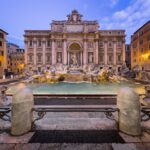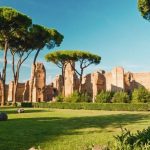Rome, at one time, was considered to be the epicentre of classic architecture, which had helped in developing some of the most important forms in building use today like, the arch, dome, and vault. This in turn led to having a major impact on the urban planning and building practices deployed over the centuries worldwide.
Rome is known for its architectural marvels and this Eternal City has no shortage of them. The famous Roman architect, Vitruvius, once said that the three principles which need to be ingrained for the architecture to be flawless are: durability, utility, and beauty. Needless to say, his ideologies have been diligently followed in most of the impressive buildings, which are found all over the capital. Some of the most noteworthy sights have been described here.
Colosseum
This famous structure was constructed during the Flavian Dynasty, between the 70 to 80 AD, and was then known as the Flavian Amphitheatre. The 65,000 spectator arena, now called the Colosseum, is one of the iconic landmarks of Rome, as well as being the most recognisable building in the entire world.
In its hey days, the Colosseum was the center of popular public spectacles such as gladiator contests, animal fights, chariot races, and even public executions. This amphitheatre is still the largest to be ever built and was modelled on the lines of another similar structure, the ancient Teatro Marcello.
Teatro Marcello
This semi-circular open air theatre was considered to be the real inspiration behind the construction of the Colosseum, which was fashioned to be circular. The foundation was commissioned by the famous Roman Emperor, Julius Caesar, and completed by Emperor Augustus in 11 BC, since the unfortunate assassination of Julius Caesar took place even before the work had started.
Located on the River Tiber, Teatro Marcello was named after the nephew of Emperor Augustus, Marcus Claudius Marcellus, who too met an untimely death at the age of nineteen. The amphitheatre has a capacity to hold 20,000 spectators and is renowned for the different forms of architecture like tunnels, ramps, arches, and columns showcasing the skills and artistry of the Romans who had a hand in designing it.
Ara Pacis
Designed by an American architect, Richard Meier, the Ara Pacis was founded in 2006 to make a home for the Ara Pacis, or Altar of Peace, which had its roots in 13 BC. The Museum portrays a fine blend of the old and the new and is truly a fascinating piece of structure to gaze upon.
The Altar of Peace has been intricately adorned with figures depicting battles and processions, housed in a chamber made of glass and steel. After the termination of the Fascist era, Ara Pacis became the first architectural offering in the historic center of Rome.
Corte Suprema di Cassazione
The highest court of appeals in Italy, the Supreme Court of Cassation, or Corte Suprema di Cassazione as known locally, is housed in a massive building on the banks of the River Tiber. The court first opened in doors only in 1911, after a long and delayed period of construction, pointing possibly towards large scale corruption which went into its making.
Locals often refer this large size and lavishly decorated building as Il Palazzaccio or “Bad Palace”, but till date easily remains as the most impressive building, inspired by the Baroque and Renaissance styles of architecture, in the whole city.
II Vittoriano
Locals call this building “The Wedding Cake” and share a similar love hate relationship with II Vittoriano as they do with the Supreme Court complex. This large altar was constructed between 1885 and 1925 to honor the first king of Italy, Victor Emmanuel.
The controversial building was made totally of white marble, complete with stairs, fountains, sculptures, and columns. The multi tiered levels of this splendid building, dominate the of Rome and is even now a focal point of the city.
St. Peter’s Basilica
Said to be one of the most sacred shrines in the whole world, St Peter’s Basilica is visited by people from far and wide. This point of pilgrimage is built above the burial place of Peter the Apostle, and is considered to be a must visit place, at least once in a lifetime.
Services of a number of architects were utilised to design the Basilica, with some well known names like Donato Bramante and Carlo Maderno to name a few. The work was completed in 1626 and contains, apart from other architectural marvels, the spectacular dome of Michelangelo, which got its inspiration from the domes of Pantheon and Duomo in Florence.
Pantheon
A true testament to the engineering and architectural skill of the Romans, the Pantheon is one of the best preserved monuments in Rome. Initially the site of a Roman temple built in 126 AD by Emperor Hadrain, the building bagan to be used as a church from the 7th Century onwards.
The word Pantheon in greek means “all the Gods” and the large circular dome roof inside the building was likely associated with the heavenly sphere, possibly to appease the Gods.
Maxxi
This museum, known as the Maxxi, was a trademark of Zaha Hadid. Maxxi is the home to the National Museum of 21st Century Arts, situated in the north Flaminio neighbourhood of Rome. The museum was conceived to showcase some of the most innovative architecture by way of rotating exhibits, sharp angles, and dynamic curves.







